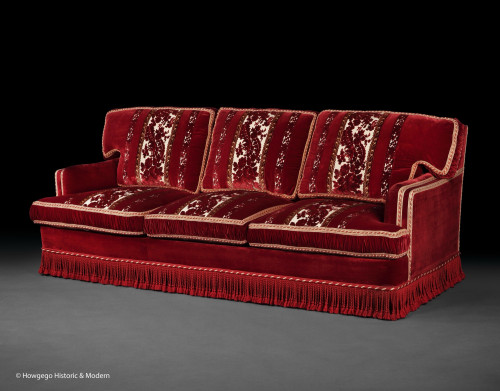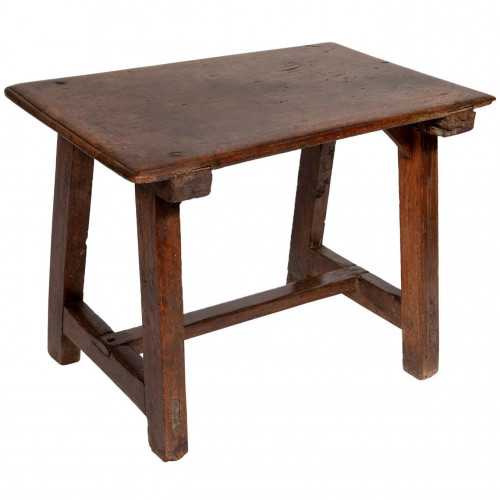A Knole Settee upholstered in velvet with inset 17th century, Brussels tapestry panels. From the Collection of the 1st Viscount Cowdray, Cowdray Park, Sussex, supplied by Lengyon & Co circa 1910
10955
The long back tapestry panel on the back is finely woven with a central cartouche with stylised fruit and leaves and putti either side. The two panels on the sides are finely, woven with putti. The panel on the front is woven with fruits and flowers echoing the back panel. The tapestries are woven in shades of blue, green, brown, beige and yellow. They have been cleaned and conserved. The velvet upholstery has been replaced. The brass castors are original.
Height 119 cm., 47 in. , Length 185,.5 cm., 73 in, Depth 95 cm. 27 ½ in.
This is a 19th century interpretation of the infamous, sumptuously, upholstered, 17th century, couch with hinged arm rests, found at Knole Park, Sevenoaks, Kent, the ancestral seat of the Sackvilles. The original couch served the dual purpose of bed and settee, and is one of the earliest examples of English, upholstered, seat furniture. This is a particularly fine example, with an exceptional provenance.
During the late-16th/early 17th century a new form of day-bed was introduced to match the contemporary upholstered 'X' chairs and stools. They were padded and upholstered throughout and the ends were let down on a toothed steel ratchet to enable the occupant to repose at full length. They were generally destroyed when the coverings had worn out at the woodwork was of little value. One survives at Knole Park, illustrated above.
Similar couches were plentiful in France under Louis XIII and can be seen in Abraham Bosse's engravings of domestic interiors but they were only found at Court and the houses of great noblemen in this country. When the contents of the Royal Palaces were dispersed after Charles I's execution a number of couches were included in the sale.
The Venetian, silk damask is in the most prized and expensive colour of the late-17th century, 'blue', brocaded with gold thread. Until the invention of Prussian Blue in the first decade of the 18th Century, a very good fast blue dye could only be made from lapis lazuli, which was extremely expensive. The colour of the silk changes with the intensity of light and appears peacock green in very little light similar to the image below. I can provide a sample of the silk to illustrate this.
FRANCIS LENYON, LENYON & CO, LENYON & MORANT
Born in England in 1877, Lenygon was trained as a cabinetmaker and studied at the South Kensington Museum in London. By 1900, he found work with Art Workshops, Ltd., and soon after with Charles Duveen, son of Sir Joseph Duveen. Employed by C.J. Charles for several years, Lenygon became well-known as cabinetmaker to England's aristocracy. He opened his own firm, Lenygon & Co., in 1904, and in 1912 merged with Morant & Co., to become Lenygon & Morant, holding royal warrants under four successive British kings.
In 1910, Lenygon made his first visit to the United States to supervise the interior decoration of Whitlaw Reid, and soon opened a New York branch of his firm. As in England, Lenygon's American clients were wealthy and sophisticated and relied on Lenygon to furnish authentic and reproduction interiors in period styles. In the 1930s, Lenygon was hired by Nelson Rockfeller to serve as a major consultant to the reconstruction of Colonial Williamsburg in Virginia, and selected all the furnishings for the Governor's Palace there.
Lenygon was widely known for his expertise in 17th- and 18th-century British furniture and interiors and lectured widely on the subjects. He served as president of the American Institute of Decorators and the Art and Antiques Dealers League of America. He was also a Fellow of the Royal Society of Arts and the North British Academy. Lenygon died in New York City in 1943. He was survived by his second wife, Jeanette Becker Lennygon, whom he married in 1926. Jeannette was also a well-respected interior designer, best known for her redecoration of several rooms in the White House during John F. Kennedy's presidency and for the interior redesign of Gracie Mansion for New York mayor John Lindsay. She was also a founding member of the American Institute of Interior Designers. Jeannette died in Evanston, Illinois, in 1977.
COWDRAY PARK
'Cowdray. I settled the terms of purchase yesterday. Price £340,000. It is a big venture, but even if the oil does not prosper and we do not become more heavily involved than our present commitment... we cannot, I think, be accused of undue rashness in buying the property.'
Pearson's purchase included the splendid ruins of the great Tudor house, as well as its Victorian successor, which had been built by the Earls of Egmont: Pearson intended to replace this, referring to his investment in oil in Mexico as 'the trade that I am in - in my dreams - hoping will build the new Cowdray Castle and finish it with one year's earnings'. War, and perhaps wiser counsels, would prevail and the Cowdrays contented themselves with altering the Victorian house.
A 'princely estate' by Pearson's own admission, Cowdray is steeped in history. Dating from the early 16th century, Cowdray was purchased from Sir David Owen by Sir William Fitzwilliam, a favourite of King Henry VIII, who obtained licence in 1532 to crenellate walls and towers on the site that had been hitherto known as La Coudreye. In 1542 it passed to Sir William's half-brother, Anthony Mary Browne, whose first son would become 1st Viscount Montague. King Henry VIII visited Cowdray on a number of occasions, as did Edward VI in 1552 (when he is reported to have complained on the food being too rich) - whilst Queen Elizabeth I's visit on her Royal Progress of 1591 was later depicted in an oil by James Pryde.
Arguably one of the finest Tudor houses in England, it was devastated by fire in 1793. Little is known of the original interior at Cowdray, save for some 18th century watercolours by a Samuel Hieronymous Grimm, which document the Buck Hall.
The Cowdrays as Collectors
Cowdray Park House was built in 1874 and has been the family seat since 1909 when it was bought by Sir Weetman Dickinson Pearson, who became the 1st Viscount Cowdray. The first Viscount Cowdray and his wife were among the most prolific and discerning British collectors of the early 20th Century. The couple and their son, Weetman Harold Miller Pearson, the second Viscount Cowdray, bought most of the antiques and artworks in the Collection.
The family started out with a small company in Bradford, which became one of the most successful business empires of the 20th Century and one of the largest construction companies in the world. The 1st Viscount Cowdray won a contract to drain Mexico City in 1889, and went on to develop vast oil fields in Mexico, accruing extraordinary wealth.
17th Century
1650
Tapestry
English
The first Viscount Cowdray, Weetman Pearson, Cowdray Park.
17th Century Interiors & Decoration (Peter Thornton) ill 150 depicts the couch at Knole











